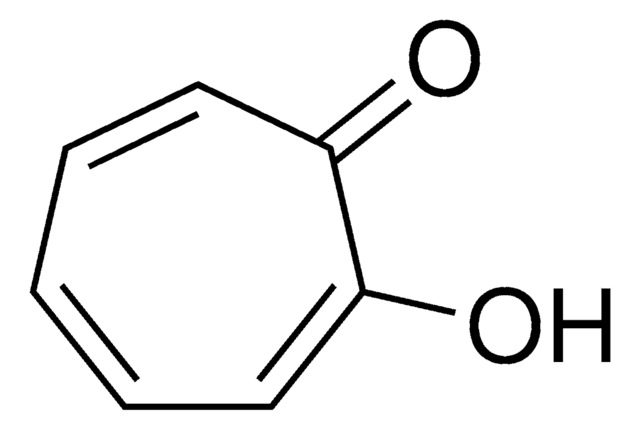Kluczowe dokumenty
137151
2-Mercaptoethanol
EMPROVE® EVOLVE
Produkcja farmaceutyczna
Synonim(y):
β-Mercaptoethanol, 2-Hydroxyethylmercaptan, BME, Thioethylene glycol
About This Item
Polecane produkty
gęstość pary
2.69 (vs air)
Poziom jakości
ciśnienie pary
1 mmHg ( 20 °C)
Formularz
liquid
granice wybuchowości
18 %
stężenie
14.3 M (pure liquid)
99.0-101.0 % (w/w)
zanieczyszczenia
≤1.0% related substances (GC) 2,2-Dithiodiethanol
współczynnik refrakcji
n20/D 1.500 (lit.)
bp
157 °C (lit.)
gęstość
1.114 g/mL at 25 °C (lit.)
przydatność
corresponds for identity (IR)
Zastosowanie
pharma/biopharma processes
temp. przechowywania
2-8°C
ciąg SMILES
OCCS
InChI
1S/C2H6OS/c3-1-2-4/h3-4H,1-2H2
Klucz InChI
DGVVWUTYPXICAM-UHFFFAOYSA-N
Szukasz podobnych produktów? Odwiedź Przewodnik dotyczący porównywania produktów
Opis ogólny
M-Clarity Program
As part of our EMPROVE® Program, our raw materials are offered with EMPROVE® Dossiers which provide comprehensive, up-to-date documentation to help you navigate regulatory challenges, manage risks, and improve your manufacturing processes.
Our comprehensive portfolio of upstream process chemicals not only provides biopharmaceutical manufacturers with high-quality raw materials for production of classical and novel therapies, but also helps them get to market faster and simplify regulatory challenges. Trust us to deliver supply chain transparency and reliable sourcing around the globe, streamlining your product qualification with best-in-class regulatory support and service.
Zastosowanie
Komentarz do analizy
Informacje prawne
Hasło ostrzegawcze
Danger
Zwroty wskazujące rodzaj zagrożenia
Zwroty wskazujące środki ostrożności
Klasyfikacja zagrożeń
Acute Tox. 2 Dermal - Acute Tox. 3 Inhalation - Acute Tox. 3 Oral - Aquatic Acute 1 - Aquatic Chronic 2 - Eye Dam. 1 - Repr. 2 - Skin Irrit. 2 - Skin Sens. 1 - STOT RE 2 Oral
Kod klasy składowania
6.1A - Combustible, acute toxic Cat. 1 and 2 / very toxic hazardous materials
Klasa zagrożenia wodnego (WGK)
WGK 3
Temperatura zapłonu (°C)
74 °C - closed cup
Certyfikaty analizy (CoA)
Poszukaj Certyfikaty analizy (CoA), wpisując numer partii/serii produktów. Numery serii i partii można znaleźć na etykiecie produktu po słowach „seria” lub „partia”.
Masz już ten produkt?
Dokumenty związane z niedawno zakupionymi produktami zostały zamieszczone w Bibliotece dokumentów.
Nasz zespół naukowców ma doświadczenie we wszystkich obszarach badań, w tym w naukach przyrodniczych, materiałoznawstwie, syntezie chemicznej, chromatografii, analityce i wielu innych dziedzinach.
Skontaktuj się z zespołem ds. pomocy technicznej








